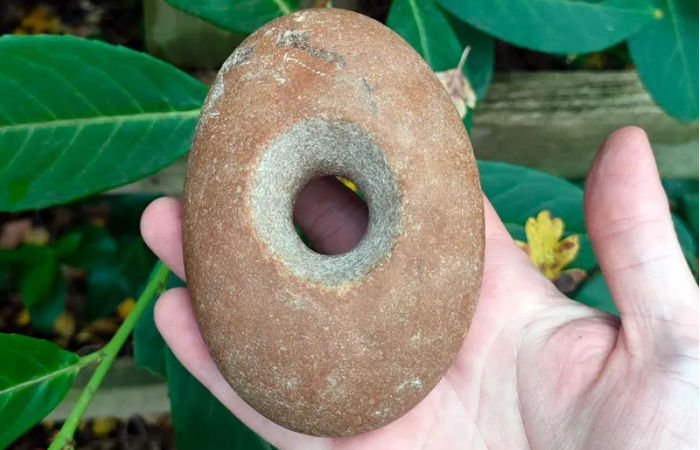Jan Bartek - AncientPages.com - Archaeologists excavating near Buckingham, UK, have found an interesting Mesolithic stone mace head.
Mesolithic hunter-gather activity is believed to have focussed on resource-rich areas such as woodland and alongside watercourses, with recorded sites generally situated on dryer, rising ground. The site was in such a location, on a tributary of the River Great Ouse.
Mesolithic stone mace head. Credit: Cotswold Archaeology
The quartzite pebble mace head found at the site is roughly oval in plan (approximately 105mm x 74mm x 40mm) with a central hour-glass perforation (approximately 35mm-20mm in diameter). Both ends of the mace head exhibit light impact damage, suggesting use as a percussive tool. Some minor wear at the narrow point of the central perforation indicates that the object was hafted.
Small chip marks around the circumference of the central perforation suggest that it was made using a technique known as pecking, rather than having been drilled. Unlike later Neolithic mace heads, which are worked to take a particular shape, these Mesolithic objects take the shape of the raw material. Similar pebble mace heads are known throughout Britain, including from sites at Eton Rowing Lake, Berkshire, and Oakhanger, Hampshire, and they are likely to also date to the Mesolithic period.
The mace head was recovered from a post-medieval quarry fill, which truncated a curved ditch. It is possible that this ditch was the remnant of a prehistoric ring ditch, with the mace head originating from a truncated internal deposit.
Credit: Cotswold Archaeology
Further ring ditches, possibly representing Bronze Age round barrows, have been identified nearby using aerial photography, and two further ring ditches, as well as Bronze Age cremation burials, are known from the wider area, Cotswold Archaeology writes in a press release.
See also: More Archaeology News
Given the resources available to Mesolithic people, the central hole probably would have taken many hours to make. Maybe they would have sat ‘pecking’ these holes at night around a campfire, whilst members of their group told stories of their hunting exploits or considered the stars.
So, whatever their function, we can imagine that these were important objects to those who invested time in making them.
Written by Jan Bartek - AncientPages.com Staff Writer
